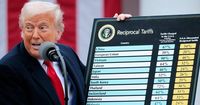The U.S. economy contracted at an annualized rate of 0.3% in the first quarter of 2025, marking the first negative reading since early 2022, according to a report released by the Commerce Department on April 30. This decline, driven largely by a significant surge in imports, highlights the disruptive impact of President Donald Trump's sweeping tariff policies as businesses rushed to stockpile goods ahead of anticipated costs.
The contraction is a stark turnaround from the 2.4% growth recorded in the final quarter of 2024, and it comes amid rising concerns that the economy could be heading toward a recession. Economists had forecasted a modest growth of 0.8% for the first three months of the year, but the reality proved to be much bleaker.
According to the Bureau of Economic Analysis, the decrease in GDP was primarily attributed to a 41.3% increase in imports, which subtracted a record 4.83 percentage points from economic growth. At the same time, government spending fell at an annual rate of 5.1%, reflecting the Trump administration's aggressive budget cuts and restructuring efforts.
Despite the overall decline, some sectors showed resilience. Consumer spending, which constitutes over two-thirds of the economy, rose by 1.8%, albeit at a slower pace than the 4% increase seen in the previous quarter. Additionally, business investment surged by 22.5% as firms sought to acquire equipment before the tariffs took effect.
Mark Hamrick, a senior economic analyst at Bankrate, emphasized the complexity of the situation, stating, "Anytime you see a contraction, or the opposite of economic growth, it is a concern. But ultimately the question also is about the outlook." He noted that global headwinds, particularly tariffs and trade tensions, are contributing to uncertainty.
As businesses prepared for the tariffs, there was a significant increase in stockpiling goods, a strategy known as front-loading. This approach led to an artificial boost in imports, which is expected to reverse in the coming quarters, potentially leading to a rebound in GDP. Analysts at Capital Economics predict a 2.0% annualized growth in the second quarter as the effects of the initial surge in imports dissipate.
Yet, the economic landscape remains precarious. The ADP reported that private employers added only 62,000 jobs in April, a stark contrast to the 134,000 jobs that economists had anticipated. This slowdown in job creation raises further concerns about the health of the labor market and overall economic stability.
Trump's administration has faced criticism for its handling of the economy, particularly as inflation remains a persistent issue. The Personal Consumption Expenditures price index, excluding food and energy, surged at a rate of 3.5% in the first quarter, prompting fears that tariffs could exacerbate price increases for consumers.
In response to the economic downturn, Trump has attempted to shift blame to former President Joe Biden, claiming that the current economic situation is a result of the "Biden Overhang." In a post on Truth Social, Trump stated, "This is Biden’s Stock Market, not Trump’s. I didn’t take over until January 20th. Tariffs will soon start kicking in, and companies are starting to move into the USA in record numbers. Our Country will boom, but we have to get rid of the Biden 'Overhang.' This will take a while, has NOTHING TO DO WITH TARIFFS."
Despite the administration's efforts to downplay the negative impact of tariffs, the economic data suggests a troubling trend. Economists warn that if the current set of tariffs remains in place, the U.S. could face a period of stagnation, with some predicting a mild recession by the second half of 2025. David Kelly, chief global strategist at J.P. Morgan Asset Management, noted that without a quick resolution to the trade war, imports and exports are likely to decline sharply.
The stock market reacted negatively to the GDP report, with the S&P 500 dropping by 1.6% and the tech-heavy Nasdaq falling by 2%. This decline reflects investor concerns about the economic outlook and the potential for further instability as the effects of tariffs continue to unfold.
Looking ahead, the Federal Reserve is expected to maintain a cautious approach in its monetary policy decisions. The central bank's next meeting is scheduled for May 7, and many economists believe the Fed will hold its benchmark interest rate steady as it assesses the ongoing impact of tariffs on inflation and economic growth.
In summary, the first-quarter GDP report paints a concerning picture of the U.S. economy as it navigates the complexities of trade policy and consumer behavior. While there are signs of underlying strength in certain sectors, the overall contraction raises questions about the sustainability of economic growth in the months ahead. As businesses and consumers adjust to the new tariff landscape, the path forward remains uncertain, with many experts urging caution as they monitor the evolving economic conditions.






